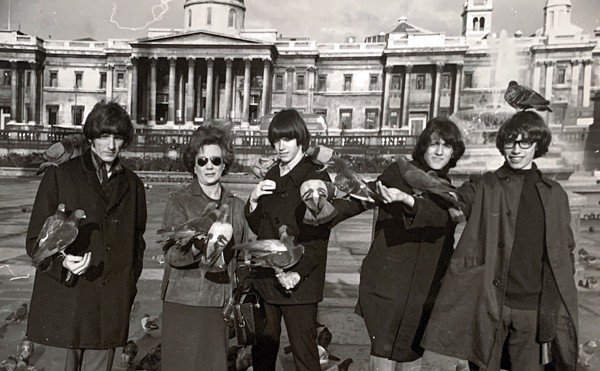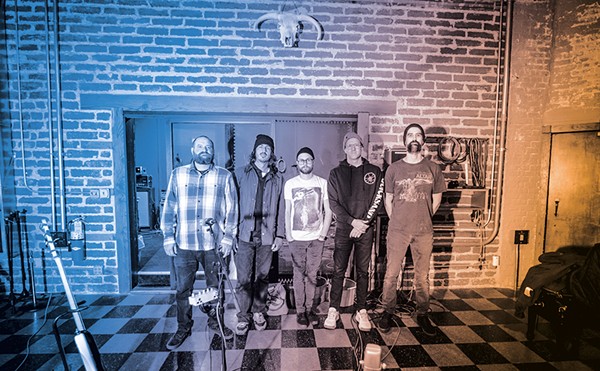Going on two years, Dave Stone and Eric Markowitz have been holding forth at the Cafe Mangia on South Grand Boulevard, playing their dense, ecstatic and, for all its elasticity, swinging jazz. They're not really young by jazz standards -- Markowitz is 30, Stone 28 -- but they're still in their jazz youth, curious and inventive about their instruments. Jazz partnerships that last a decade are rare; this duo's free but fluid approach to improvisation has evolved through 10 years of musical and daily friendship. "Eric puts up with me musically," Stone laughs. "We've been really close friends for a long time. We'd hang out every day for the first three years we knew each other, always listening and playing." For about as long as either has played jazz, they've played together. "I've played more hours with Dave than with anybody," Markowitz says. "We both take music pretty seriously. For some people, music is just a fun thing, and that's fine, but for both of us, music is one of the reasons to be alive. Underneath the music, how you feel about it, is really the most important thing."
Stone and Markowitz studied together at Webster University, but both hold most dear their apprenticeship in the '90s with two St. Louis jazz masters, Joe Charles and Jimmy Sherrod. Stone calls them "the source." Markowitz explains: "We used to go over to local drummer-slash-mentor Joe Charles' house. That's where we did our woodshedding. Charles is the reason I can play today. He's since passed away. He played with Grant Green here in St. Louis, and there are a lot of stories that Coltrane asked him to join his band, but no one knows for sure. He was a master musician, master teacher, one of the most beautiful people I've ever known. He shared all of his knowledge for nothing. If it was up to him, we'd have been over there 24 hours a day, seven days a week. We'd play like crazy for hours on end. At the same time, we were rehearsing in another band, with Billy Teague on drums and with Jimmy Sherrod, a saxophone player who I consider my other musical teacher. Monday, Wednesday and Friday, we'd go over to Joe Charles' house, then Tuesday and Thursday we were at Billy Teague's playing with Sherrod. For this learning period we were playing every night of the week."
Stone and Markowitz also share a common musical touchstone: John Coltrane. When Markowitz says he's a Coltrane fanatic, he's only half-joking. "There are days when I wonder if he was really human," Markowitz says. "It's really his feel, his aesthetic, and concept of music."
"Even from the very beginning he was an amazing musician," Stone muses. "He had his own sound, his own harmonic approaches. The whole time he played there was exponential growth. It's just exciting to listen to that total involvement. Not to get all goo-gah on you, but there's a spiritual nature to his music. I really appreciate that, because I don't have any specific religious beliefs. It's good to put on a Coltrane record and see that there's one guy who loved everybody."
Even when Stone and Markowitz address a tune like "All the Things You Are," a standard nearly every major bebop player but Coltrane recorded, you can hear Trane's presence. At one point, drums and vibes recede and it's just Stone and Markowitz, at opposite ends of the group, communicating their codes along the most elusive traces of melody, but with such concentration and empathy, with such harmonic regard for the other's instruments, that the code isn't difficult or secret at all. The improvisation sinks in like certainty.
"There are differences between our approaches," Stone, who played speed- metal guitar in his youth, explains. "I tend to play against the changes a lot harder, but that's mostly because I can. Unlike Eric, I have zero responsibility to delineate what's going on harmonically. Not everything I'm trying is to everyone's taste, and I'm not even sure the people I'm playing with are always into it. We used to play more tunes that were less standardlike. But now we keep defaulting to basic song structures. It's easier to hear the stuff that you want to pile up on that, as opposed to playing Wayne Shorter tunes, where the changes are less traditional. It's much harder if you try to go out on that stuff without a chord player. The tunes we play are very specific to the trio instrumentation. The complexity really doesn't go much beyond what Coltrane did in '63. We never break the tune; the tune remains there the whole time."
"What we're doing is very abstract to a lot of people's ears," Markowitz says. "There's no clearly defined harmony, especially when there's no regular chord player. I'm playing one note at a time, a bass note, and I'm trying to imply the harmony and the movement of one chord to the next. Dave is just playing melodically over those things. What he does implies the harmony as well. There's just two lines going on. I can hear the tune going by in my head, and it's still abstract to me. If you can't hear the tune going by in your head, there's no way you can understand what's going on."
Depending on the night, the trio is completed by one of two drummers: Kyle Honeycutt on Saturday, Jim Orso on Friday. "Kyle is a more mellow player, quieter," Stone says. "He has a real nice, relaxed Billy Higgins style. Jim's more driving, almost an older style, more bebop, with a little more Elvin Jones." "He has so much energy," Rickard adds, "and he's learning stuff so fast that he's always growing. He's gotten more energetic, more polyrhythmic over the last year." At age 22, Orso has also gone from playing in a high-school heavy-metal band called Vendetta to becoming a regular with some of the most adventurous musicians on the scene, including Rob Block, Paul DeMarinis and Dave Eubanks.
Part of what's so remarkable about the improvisational art of this sometime trio, sometime quartet, sometime jam session, is the way it directs some pretty abstract sounds -- harmonies are suggested, melodies smeared -- into an experience that's no more abstract than the deepest feelings, those emotions we know are true because we couldn't begin to plan or define them. But rather than torch design altogether -- though Stone does just that on his free-jazz gigs every other Wednesday at Mangia -- these weekend outings test the way freedom and form complement, even need, each other. "I don't have a problem keeping the form, as they say," Stone explains. "The form doesn't have to get elongated or crunched. Sometimes it gets pretty crazy, but maybe in our minds there's a certain distaste for groups that play jazz and on every solo the sax player has an aneurysm while the group's playing "Bye Bye Blackbird,' and so it's like they're playing to the audience in a way that's lower than they're capable."
For Markowitz, the music is, finally, a way of listening: "Jazz only makes sense when people are listening closely to each other. The best jazz is when the members of the group seem to be telepathic, listening so close, knowing each other so well. The longer I play with this group, and the more I get to know them as people, the better it gets."





